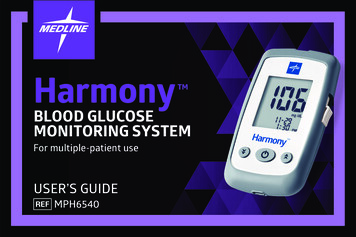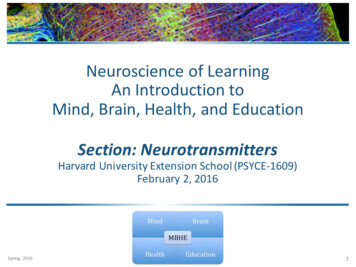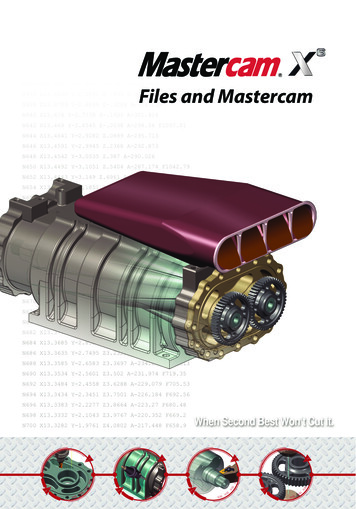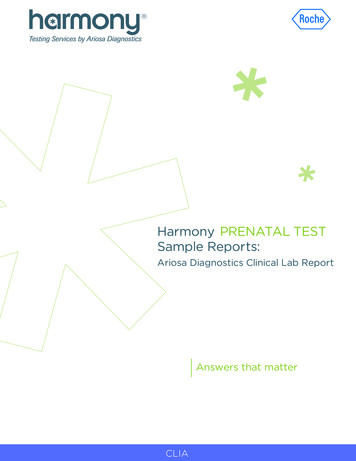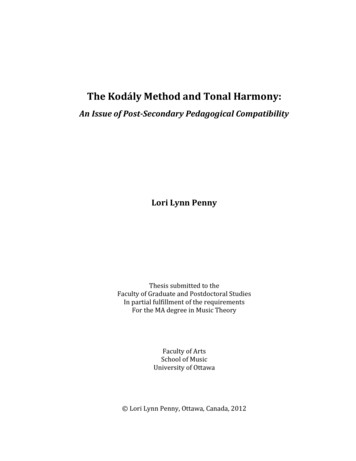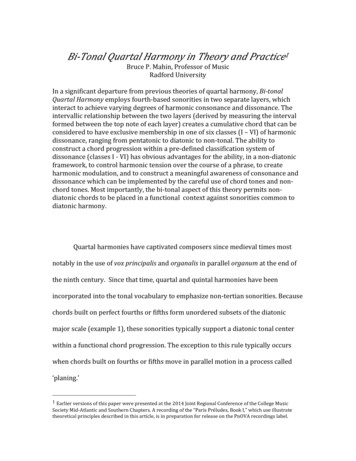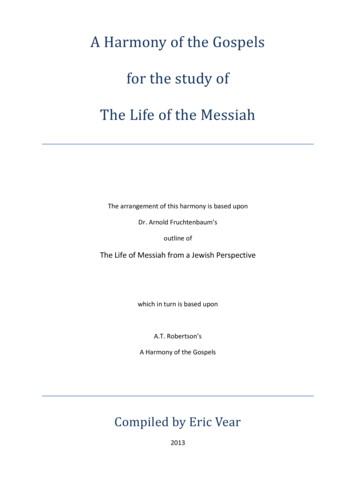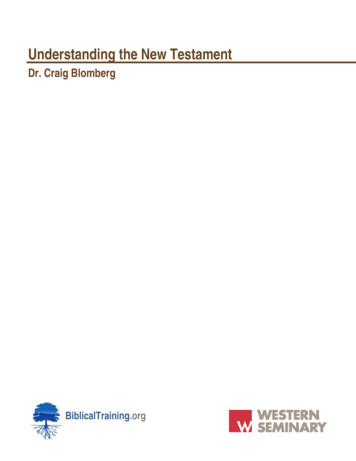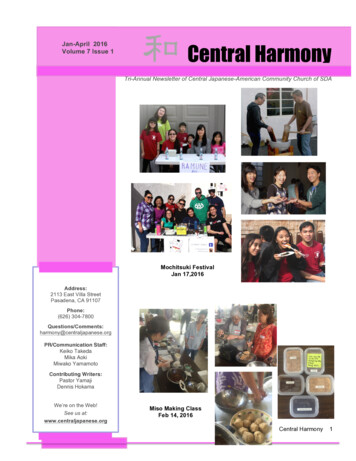
Transcription
Jan-April 2016Volume 7 Issue 1Central HarmonyTri-Annual Newsletter of Central Japanese-American Community Church of SDAMochitsuki FestivalJan 17,2016Address:2113 East Villa StreetPasadena, CA 91107Phone:(626) .orgPR/Communication Staff:Keiko TakedaMika AokiMiwako YamamotoContributing Writers:Pastor YamajiDennis HokamaWe’re on the Web!See us at:www.centraljapanese.orgMiso Making ClassFeb 14, 2016Central Harmony1
Message from Pastor Tadashi YamajieeAThe Flame of the Holy SpiriteerreaCeDEgereCCeeeeCeeeCeeCeaeCDMMeee DaeeCeeDaaeeDeraCaaeDeCDMeCeMaCD DaDgeea aMeCCDMeeeCMDA eCDeeeaeMeeMaae DaeMDeCCDaeaeaareeCeCeDeeeeeaCMeeMeDaCaageA Christian revival meeting was held in a small town in the US. Atthe end of the meeting, many people decided to become Christiansafter being invited to believe in Christ. Among them, there was amiddle-aged couple.After the meeting, the couple approached the pastor as a preacherand said, “To be honest, we came here to banter after we saw theinformation about the revival meeting. In the beginning, we tried tofind fault and ridicule the content or program of themeeting. However, an unexpected thing has happened! We felt thepower of God so strong that we could not help going in front at theend of the meeting.” After they said to him, both grabbed thepastor’s hands firmly without wiping their tears. As if God’s tongueof flame burned their impurities and haughtiness and gave themfaith to purely believe in God. This is how people’s hearts arecleansed.“ no one can enter the kingdom of God unless they are born ofwater and the Spirit.” John 3:5EEJesus worked as a light to shine in the world through His life asSavior. Just like olive oil was fuel for lamp, He who was filled withthe Holy Spirit worked as a light to shine in the dark world. Jesusalso healed many people with sickness. Just like olive oil was usedas medicine to heal wounds, Jesus filled with the Holy Spirit healedpeople’s mental and physical wounds. Sometimes oil is used aslubricant for machines to move smoothly. If we open our hearts, theoil of the Holy Spirit will become lubricant for our hearts. Even whenour lives don’t move with our daily concerns and living burden, theHoly Spirit will enable us to walk smoothly toward tomorrow.The garbage in our lives has to be burned into ash. And only theflame of God can do that for us. When God’s holy flame touchesour hearts, He burns all the trash including our pride and ego, ourstubborn assumption and hypocritical attitude, impatient and meannature and instead, gentle and kind natures like Jesus Christ will bereplaced. How many times have we got despaired of the ugliness inour hearts and sought help? In response to such our desire, Godwill burn up our impurities in our hearts like a burning flame. Andafter all the impurities are burnt, new hearts that we hadn’t realizedbefore will grow.agaTe aCDa CaaMCECDuring the biblical era, especially olive oil had not only been usedas fuel for lamp but also used as medicine to heal wounds,cosmetic,condiments orused forreligiouscleansingceremonies. God commanded Moses to prepare the anointing oilwhich represents Holy Spirit. In the Bible, when people in position toplay the special roles such as kings, priests or prophets are chaired,the ceremonies of appointment were conducted by pouring anointingoil. The Bible says when Jesus Christ started his ministry as Saviorand was baptized in Jordan River, the Holy Spirit from heavendescended on Jesus like a dove. What it means is that Holy SpiritItself ――NOT anointed oil which originally represented HolySpirit ―― was poured on Jesus at the appointment ceremony toappoint Him as savior.CMaCA)Central Harmony2
The 70th Anniversary of CJACC Part I: The Long, Winding Road to 1946IntroductionIn preparing this paper, I am deeply indebted to Elder AkiraKitabayashi’s 1980 Master’s Thesis called “A History of Church GrowthAmong the Japanese Believers of the Seventh-day Adventist Church,”and to Elder Tadashi Yamaji for sending me his recently scanned copyof it. I know Elder Kitabayashi personally, and we have something incommon. Both of us have married into the Okohira family, which isintertwined prominently in the history of the Japanese SDA work in1Japan as well as in the United States.I had read his thesis with great interest soon after it was written, andas it happens, I have personally known many of the individuals hementions, going back as far as the early 1950s. In my opinion, notharticle about the 70 anniversary of LA Central church would berespectable without an acquaintance with it.His research methodology was based mainly on taped interviews ofsurviving charter members of the eight Japanese SDA churches inCalifornia. In his report, Elder Kitabayashi was very concerned thatunless such a history was written then, many of the principalparticipants would pass away, and no longer be directly accessible ashistorical sources. The subsequent passing of another 36 years hasturned his concern into a reality, making his history even morevaluable today. In this paper, unless I cite another source, I will simplycite the page number of Kitabayashi’s thesis as documentation.I have supplemented my source material by interviewing June (94)and Ben (83) Ohashi as well as Ted Okohira (83) who are still able toremember some things going back to 1946 and beyond.Why Bother to Have a Japanese Church?thBefore we begin uncritically celebrating the 70 anniversary of ourfounding, however, it seems appropriate that we should take a fewminutes to ponder the question, “Why Have a Japanese Church?” Thisvery question virtually tore this very church apart in the late 1990s,when we had an identity crisis while debating the question of a mergeror relocation. Some members went so far as to suggest in writing thata “Japanese” church was an expression of racism. In response, I wrotean essay with this very title in 1998 that was circulated in this church2that can still be found on the internet. I have subsequently defended itin the Lome Linda University Church in a Sabbath afternoon paneldiscussion on the merit of ethnic churches. The same question alsoarose in a Southern California Conference constituency meeting about20 years ago at which I felt obligated to speak up. If I were writing ittoday, I would change a few words, but I have extracted some keyparagraphs from it:“Those who would argue against ethnic churches overlookthe obvious fact that while God may be culture free, peopleare not, cannot, and I would argue, should not. Ethnicchurches must exist to offset (not neutralize) human biases;not to placate God's lust for kim chee, chow mein, sushi,refried beans, or collard greens. If God is unprejudiced anddesires salvation for all, then He cannot be satisfied as longas there are environmental/ cultural barriers to salvation forANY group. Ethnic churches are justified because God is notwilling that any should perish, merely because they refract lifethrough the prism of any particular culture.As SDA’s of Japanese culture or descent in the greater LosAngeles area, it is our unique mission to destroy culturalbarriers against the gospel for people identifying with theJapanese culture. It is a mission for which the Los AngelesCentral Japanese Church is uniquely qualified.As the only full service Japanese SDA church in the greaterLos Angeles area, we need not apologize to anybody forfeeling a burden to maintain it.”In short, those who wish to dispense with ethnic churches don’trecognize that they only think that because their particularculture/ethnicity just happens to be identical to the dominantculture/ ethnicity of that particular region. But in fact, there is nosuch thing as a person without the characteristics of a particularethnicity or culture. So every church is an ethnic church of onekind or another. With that misunderstanding out of the way, let’scelebrate the history of our Japanese-American church!The Founding in 1946The bare facts are that on January 26, 1946, the entity that hastoday morphed into something that answers to the name of“Central Japanese-American Community Church,” came intoexistence as the Los Angeles SDA Japanese church. It had 50charter members, and their minister was Elder Alfred T. Okohira.They were at that time meeting as a company in the chapel ofthe White Memorial Hospital. (39) They would not move intotheir church located at 3010 Eagle Street in East Los Angelesuntil a few years later.3Some of the Issei (first generation Japanese in America )names mentioned in connection with the church’s founding are:4Dr. James Hara, Mrs. Masa Nakamura, Mrs. Himo Sakai, Mr.Heimatsu Nakashima, Mrs. Chie Fujikawa, and Mrs. Shige5Takakura.Some Kibei (Niseis who had returned to the Unites States afterstudying in Japan) names are:678Shirou Kunihira, Sakae Fuchita, Jack Kiyonaga, Taira9ShinoharaThe reason why the White Memorial Church (WMC), and theWhite Memorial Hospital figure so prominently in early Japanesechurch history is that until the mid 1960s, Loma Linda UniversityMedical School (formerly called College of Medical Evangelists,or CME) students spent their last two years of medical school atWhite Memorial Hospital. This effectively made the WhiteMemorial Hospital an extension of CME/LLU, and earlyJapanese medical school graduates found it natural to becomemembers of the WMC. The earliest of those was Dr. James Hara(1915), but others were to follow. (25) Because of the Japaneseconcern for health, it was natural for new Japanese SDAmembers to feel secure worshiping with Japanese medicaldoctors, so WMC became their first gathering place.Elder Alfred Okohira had arrived in Los Angeles in 1931, havingbeen hired by the Conference as a minister right after graduatingfrom Pacific Union College that same year. (26, 27) The son ofElder Teruhiko H. Okohira, the first native born Japanese SDAmember and minister in history, was fulfilling the first part of hisfathers dying wish:“Go to the United States and study to become aminister. When you finish your service in the UnitedStates, return to Japan to help the work which I have10started.” (26)Our Place in HistoryTo put the founding of the Los Angeles Japanese SDA churchinto broader historical perspective, two other Japanese SDAchurches had already been organized in California under theleadership of Elder Kinichi Nozaki, who was ordained in 1924:The Mountain View Japanese church in 1929, and the SanFrancisco Japanese church, in 1938. (20) Although Kitabayashidoes not say so, those two churches were almost certainly thefirst two Japanese SDA churches in the entire United states.The third Japanese church SDA church to be organized wasalmost certainly the Honolulu Japanese Church, on January 6,Central Harmony3
Dennis Hokama111940, with 32 charter members and Shohei Miyake as pastor. (TheSacramento Japanese church would not be organized until 1957.(93))Although Kitabayashi does not deal with any Japanese churchesoutside of California, to this day, I have never heard ofany Japanese SDA churches outside of California and Hawaii otherthan the Seattle Japanese church founded by Elder Victor Kumaji12Inoue that my father was called to serve in 1960 when Elder Inoue13retired. While I do not know when the Seattle church wasorganized, Inoue was by then a white haired old gentleman whoappeared to be at least in his late 60s, and they were just buildingth14their first church (200 20 Street, Seattle, WA 98144 ) when wearrived. It is probable that they were organized in the 1950s, thoughan earlier date in the 1940's is possible.When all of the above has been considered, it means that the“Central Japanese-American Community Church,” is almost certainlythe fourth Japanese-Amercan church to be organized inthe United States.The Long, Winding Road to 1946History is never just about remembering certain arbitrary dates. It ismore about understanding why certain events happened in relation toother, perhaps larger, world events. Why did it take 15 years from thetime Alfred Okohira arrived in Los Angeles in 1931 to the formation ofthe first Los Angeles Japanese church in 1946?The macro-event that entirely changed Japanese church historyforever was of course the bombing of Pearl Harbor by the JapaneseImperial Navy on December 7, 1941. That nearly crushed the15fledgling Japanese SDA church in Hawaii headed by Elder Miyake,and scattered the members of the new Japanese churches andgroups on the West Coast to the wind, due to executive order #9066issued by F.D. Roosevelt on February 19, 1942.In the spring of 1942, like thousands of other Japanese on the West16coast, the Alfred Okohira family had been ordered to pack up theirclothes and get on a train to a relocation camp away from the Westcoast. Their particular destination happened to be Poston, Arizona,17where they would spend approximately the next year and a half.After that it would be on to Delta, Colorado for another year and a18half before they were allowed to return to Los Angeles.But unlike a lot of other Japanese headed to internment camp,Alfred Okohira had an advantage that was to make a great differencein the Japanese work when they finally were allowed to return to LosAngeles three years later. Their neighbor and great friend, a Germannamed Mr. Herboltzeimer, had agreed to rent out his vacant house,collect the rent, and make his loan payments while he was gone. Hekept his promise, so when they returned, their house on19Pennsylvania Avenue was in good shape, and they were handed20the accumulated rent.In 1945-1946, a time when most of the other Japanese werereturning to the West Coast having lost everything due to internment,Elder Okohira had a large property that served as a dormitory forthose Japanese who were trying to restart their lives. Thus, evenbefore there was a Japanese church, his house was like an oasis in adesert, serving the congregation to be, as a hotel of last resort in thatdifficult post-WWII transition period for Japanese-Americans.Ben Ohashi, for example, got out of the camp in Heart Mountain,Wyoming and came to Los Angeles in 1946, looking for a place to21stay while he completed his high school education. He stayed at theOkohira’s Pennsylvania property for a year while he attendedLynwood Adventist Academy and fondly remembered Mr.2223Herboltzeimer and the Matsuda couple from the Bay area whostayed in their back house.Reflections on Order #9066Looking at the large picture, what overall effect did order #9066have on the Japanese immigrants in general, Japanese SDA workin California, and the Los Angeles Japanese SDA church inparticular? I have thought about these questions for a long time.While it is always politically incorrect to see silver linings in whatwas undoubtedly a great tragedy for many, being p.c. has neverbeen my concern.On a national level, I generally tend to agree with the greatJapanese-American semanticist Sam Hayakawa whomKitabayashi quotes:The wartime relocation, despite the injustice, andeconomic losses suffered, was perhaps the best thingthat happened to the Japanese-American of the WestCoast. As many say, the relocation forced them out oftheir segregated existence to discover the rest ofAmerica.The relocation thus resulted in the Americanization ofthe Japanese in one generation after immigration .arecord for non-English speaking of any color. (33)Although Hayakawa did not have Adventism in mind, exposure tohard working Japanese SDA ministers (which is an aspect ofAmerican culture) in the camps preaching to captive audienceswas one of those “discoveries.”Elder George Aso (who was one of those hard working relocationcamp Japanese ministers) wrote to him as follows:I do not know if this is universally true, but I have oneorganization whose blessings outweighed the curseswhich war usually brings about. And that organization isthe Seventh-day Adventist Church in the United States.Indeed, if it was not for that war and the subsequentrelocation of their believers, perhaps the (Japanese)Adventist churches in California would not have24experienced the growth which they enjoy today. (33)With respect to the Los Angeles Japanese SDA church, becauseof the Elder Okohira’s incredible added blessing of having awonderful, loyal neighbor, (some will call it providential) the silverlining to order #9066 was even more pronounced, as we havealready seen.Central Harmony4
End Note1. Elder Teruhiko Okohira, Pat Hokama’s grandfather, and Melissa and Krissy’sgreat grandfather is credited in the SDA Encyclopedia with being the first SDAmissionary to Japan in 1896, along with W.C. Grainger, then the President ofHealsberg College, which became Pacific Union College. P. 1026-1027.(7)2. http://orionmonitor.com/02/om9802x.htm3. It should probably be said here that “Nisei” means second generationJapanese, and “Sansei” means third generation.4. He left Japan at the age of 16 with ambitions of pursuing a career in medicine.While working as a bell hop, he was introduced to Adventism. He entered WallaWalla College as a pre-med student, and in 1912 entered CME/LLU. He beganattending the White Memorial Church from his junior year in medicine (1915)because White Memorial Hospital was where all medical students spent their lasttwo years.(24, 25)5. Mrs. Takakura came to be known as “Takaobachan” and I came to know herwhen I began attending LAC in 1975. Ted says her husband was their cook inPostom, and they subsequently became close family friends in Los Angeles. Patsays she used to baby sit her when she was a child.6. He would would eventually become the minister of the Mountain ViewJapanese Church, be a missionary to Japan, and become a professor ofpsychology at Loma Linda University after earning a Doctorate in that subject fromStanford University.(27)7. He would also become a minister and serve in post war Japan, as well asreturn to the U.S and help organize the Japanese work in Gardena, and pastorthe Los Angeles Japanese church. (27)8. He would graduate from CME-LLU as a doctor and establish a practice ininternal medicine in Gardena. As a charter member of the Gardena Japanesechurch and a board member of the East-West Language School (Tozai Gakuen)he exerted great influence. (27,28)9. He would go on to study theology at Madison College and be a strongsupporter of the Los Angeles Japanese church (28)10. In retrospect, we can say that although his father would have been proud ofhis long ministerial career in the United States, he never did return to work as aminister in Japan.11. “A Brief Chronological Adventist History of Hawaii,” prepared by Hideo Oshitain 1961, 2. Some spell this name as “Inouye.”13. June Ohashi grew up in Auburn, Washington, and was a 1939 graduate ofAuburn Academy (also my alma mater). Although she could not initially rememberInoue’s first name, she remembers his three children: Lois, Ann and Sam.However, when I called her on 2/19, to ask if it his first name was “Victor,” sheconfidently affirmed this and said his middle initial was “K” which she had affirmedon my first visit. I later noticed that Kitabayashi mentions a Kumaji Inoue fromWashington State. (32)15. Elder Miyake was the father-in-law of Dr. Paul Tatsuguchi, a graduate ofPUC and Loma Linda Medical School, class of ‘38, who had beenconscripted into the Japanese army. His last letter to his wife made asensation around the world, and eventually led to Miyake’s firing. (I wroteabout this incident in more detail in “The Life and Times of Mrs. O”)16. Kitabayashi gives the total number of Japanese relocated as 110,000.70,000 of them were citizens by birth. (32)17. Although Kitabayashi does not mention it, and have as yet noindependent documentation of this, I have heard repeatedly from variousmembers of the Okohira family that while in Poston, Elder Okohira wasallowed to be a chaplain that was allowed to visit various Japanese camps inthe area.18. Ted could only give me approximate dates when I interviewed him on2/18/2016. However, we do know that order #9066 was rescinded onJanuary 2, 1945.19. That property on Pennsylvania, which was near the intersection withCummings, no longer stands, because it was bought by the state undereminent domain and now lies under the #10 freeway as it turns south to jointhe #60 freeway. Pennsylvania borders the southern end of the WhiteMemorial hospital, and Cummings is the next major intersection east of StateStreet, which is the eastern border of White Memorial Hospital. Its closeproximity to the White Memorial Hospital implies the close relationship theJapanese church had with the White Memorial lvania Ave, Los Angeles, CA 90033/@34.0399209,118.2159436,14.22z/data !4m2!3m1!1s0x80c2c60df91908b5:0x337ebcea64acc198 )20. Even though Ted confirmed this story, I distinctly remember, as if it wasyesterday, Gracie (Okohira Suzuki) excitedly telling me this story for the firsttime with animated hand gestures of him handing over the rent. It is, IMO,one of the most uplifting and inspiring stories of the Japanese internmentexperience. Without his loyalty and integrity, the history of the Japanesechurch might be quite different.21. Ben, newly baptized by Elder Nozaki at Heart Mountain, went to LynwoodAdventist Academy where he was a classmate of Ted Okohira, one yearahead of Grace.22. Ben says that he has visited Herboltzeimer’s head stone in the EvergreenCemetery.23. Not Paul and Janet. They would come later.24. Elder Aso’s “today” was 1980. In the 36 years that have passed sincethen, unfortunately, his words ring even more true today. The iron clad rule ofchurch history is that a church prospers most when it is perceived asproviding a vital service by the community it wishes to serve. The iron cladrule of church history is that a church prospers most when it is perceived asproviding a vital service by the community it wishes to serve. That appears tobe an increasing challenge the further we move away from 1946.14. That church now belongs to the Church of God, and there is no longer aJapanese SDA church in Seattle. What was left of the Japanese church hasmerged with the Greenlake church many years ago.Central Harmony5
CJACCrMe(eeeaeMMCDTCDMeMMe 30. eeeACSaCeeD EeeeaCaeeCMDMaMe)CeeCCaMeeaC(ee16897 eeaeeaCMeMECCeeeA)eeCAaCaeeMMeeagaeaMCaCCDeCee 0.MreeaetCea1998CerCeCaeeC52/ aD30.CeeaCeEe)TCeeCeDeeaCCTrAeTeCeTCentral Harmony6
ATCeAeeCeMaeeaeeeeDeCCDMCeeMere eDeEeeaeeDeeDaeeeEgaeDa(eeleeDCeeeCCCentral Harmony7
ANNOUNCEMENTSCampmeeting at Drayson Center in Loma LindaSaturday March 19Easter ServiceSaturday March 26 at 11 amEaster social and Egg huntSunday March 27 at 11 am - 2:30 pmIf you interested in participating in the Easter Egg hunt, please bring a dozen eggs per child (eitherboiled and colored, or plastic eggs filled with treats)San Gabriel Academy Alumni weekend 5k RunSunday, April 24 at 8:30 amIf you are interested in joining the CJACC group for the run, please contact Aaron Hays by April 1, andDO NOT REGISTER ONLINE. Group rate will be 25/person, and after April 1st will be 30/person.For more information on the run, visit www.run4sga.org! ONLINE GIVING IS AVAILABLE!Tithe and donate to your ministry of choice by using your Visa, Mastercard, Discover, or Debit Card.Please visit our website at www.centraljapanese.org and click the“TITHE AND DONATE ONLINE” tab.Weekly/Monthly/Quarterly Events* Japanese Language Ukulele Group* Japanese Language Bible Studies* Japanese Language Prayer Meeting* Total Life Seminar (Japanese Language)* Family Fun Night* Women’s MinistryTues 10am-11amTues 11am-12pmWed 10amThus 10am-2pmMonthlyQuarterlyIf you would like to be added to our email list for announcements andupdates, please contact Melissa at nese.org.Central Harmony9
Central Harmony10Central Japanese-American Community Church of SDA2113 East Villa StreetPasadena, CA 91107
Central Harmony 1 Central Harmony Jan-April 2016 Volume 7 Issue 1 Tri-Annual Newsletter of Central Japanese-American Community Church of SDA Mochitsuki Festival Jan 17,2016 . If we open our hearts, the oil of the Holy Spirit will become lubricant for our hearts. Even when our lives
